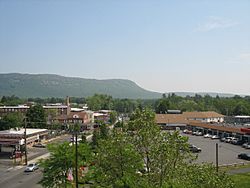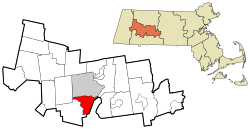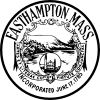Easthampton, Massachusetts facts for kids
Quick facts for kids
Easthampton, Massachusetts
|
|||
|---|---|---|---|

View of Mount Tom from the center of Easthampton
|
|||
|
|||
| Motto(s):
Artes et Literæ cum Virtute Conjunctæ (Latin "Arts and Letters joined together with Virtue")
|
|||

Location in Hampshire County in Massachusetts
|
|||
| Country | United States | ||
| State | Massachusetts | ||
| County | Hampshire | ||
| Settled | 1664 | ||
| Incorporated (district) | June 17, 1785 | ||
| Incorporated (town) | 1809 | ||
| Incorporated (city) | 1996 | ||
| Government | |||
| • Type | Mayor-council city | ||
| Area | |||
| • Total | 13.60 sq mi (35.23 km2) | ||
| • Land | 13.32 sq mi (34.50 km2) | ||
| • Water | 0.28 sq mi (0.73 km2) | ||
| Elevation | 170 ft (52 m) | ||
| Population
(2020)
|
|||
| • Total | 16,211 | ||
| • Density | 1,216.86/sq mi (469.82/km2) | ||
| Time zone | UTC−5 (Eastern) | ||
| • Summer (DST) | UTC−4 (Eastern) | ||
| ZIP Code |
01027
|
||
| Area code(s) | 413 | ||
| FIPS code | 25-19370 | ||
| GNIS feature ID | 0608739 | ||
Easthampton is a city in Hampshire County, Massachusetts, in the United States. It is located in the Pioneer Valley, close to the college towns of Northampton and Amherst. In 2020, about 16,211 people lived there.
Contents
Easthampton's Story: How the City Grew
Easthampton started as a small village called Pascommuck in 1664. It was first part of Northampton. In 1704, during a time of conflict, a group of Native Americans attacked the village. This event caused many residents to lose their lives.
From Village to City: Key Dates
Even after the attack, the village was quickly rebuilt.
- In 1785, Easthampton became a "district" in Massachusetts. This meant it had some independence but was not yet a full town.
- In 1809, it officially became a town.
- Easthampton is the newest city in Hampshire County based on when it became a city.
- In 1996, Easthampton changed its rules to become a city.
How Industry Shaped Easthampton
The town grew a lot around the Manhan River. At first, it was mainly a farming community. Later, during the Industrial Revolution, factories and mills were built. These mostly focused on making textiles (cloth) and related products.
- The first big factory, the Williston-Knight Button Company, started in 1847. Samuel Williston, whose father was the town's first minister, founded it.
- This company made popular cloth-covered buttons. To power the machines, a local brook was dammed, creating Nashawannuck Pond.
- Soon, other mills opened, making things like elastic and rubber threads.
Growth and New Services
As industries grew, Easthampton added many new services:
- In 1864, the town opened its first high school and its first national bank.
- A town hall was built in 1869.
- The town got its first police officer in 1871.
- Easthampton became a regular stop on the railroad in the same year.
- The public library opened in 1881.
- In 1895, telephones and streetcars arrived, making life easier for residents.
- Many new churches were built for different groups of people.
- In 1899, two large cloth-making companies moved to Easthampton. They brought many new workers, especially from Poland and Canada.
Challenges and Changes
During World War I, Easthampton's mills did well because they had contracts to make things for the war. However, before the Great Depression, many factories started to struggle. They laid off workers or tried to merge with other companies.
- One success during this time was the American Character Doll Company. One of its founders invented the first rubber doll sold widely in the United States.
- World War II helped the economy again, as factories received more government contracts.
- But in the 1960s, many important factories closed.
- Efforts to bring new jobs included an industrial park and an industrial mall. However, these did not fully solve the higher rates of unemployment and poverty compared to the rest of Hampshire County.
Easthampton Today: Arts and Community
Today, small farms and local businesses are important to Easthampton's economy. Since becoming a city in 1996, the downtown area has become a home for artists and young people. They are drawn to Easthampton because it costs less to live there than in nearby Northampton.
- Many small shops on Main Street, Union Street, and Cottage Street have changed to fit this new group of residents.
- This growth has led to new arts and cultural events. One popular event is Art Walk Easthampton, where artists show their work every month.
- In 2018, the state government gave a large grant to help redevelop the Ferry Street Mill project in the city.
Where is Easthampton?
Easthampton is located in the southern part of Hampshire County.
- It shares borders with Southampton and Westhampton to the west.
- To the east and south, it borders Holyoke.
- Northampton is to its north.
- The Connecticut River forms a boundary with Hadley to the northeast.
- The western sides of Mount Tom and Mount Nonotuck are on its eastern border.
Roads and Rivers
- Massachusetts Route 10 goes through the center of Easthampton. It is called Main Street and Northampton Street.
- This route leads about 5 miles (8 km) northeast to Northampton and 4 miles (6 km) southwest to Southampton.
- Massachusetts Route 141 (Union Street, Cottage Street, and Holyoke Street) goes southeast from Easthampton's center. It passes Mount Tom and goes about 6 miles (10 km) to Holyoke.
- Interstate 91 and U.S. Route 5 cross the northeastern part of Easthampton near the Connecticut River. These roads go north to Northampton and south to Holyoke.
Land and Water
Easthampton covers about 13.60 square miles (35.2 square kilometers). Most of this is land, with about 0.28 square miles (0.7 square kilometers) being water. The Manhan River flows through Easthampton, north of the city center. It then flows into The Oxbow, which is an old channel of the Connecticut River.
Learning in Easthampton: Schools and Education
Easthampton has a long history of education.
- In 1797, the town had four school districts.
- By the mid-1800s, there were more than twelve small schools.
- Over time, the town built larger schools to teach more students. For example, an eight-room school was built on Maple Street in 1897.
High School History
- Sarah Chapin, a graduate of Mount Holyoke College, became the town's first high school principal in 1864. She created the first lessons for the school.
- In 1864, the town built a two-story building for its first high school.
- A new high school was built in 1912. The old building was then used as an elementary school and is now used for city offices.
- In 1975, the 1912 high school building became the Neil A. Pepin School.
Current Schools in Easthampton
As of 2023, Easthampton has several schools:
- Mountain View School: This is a public school for students from pre-kindergarten to 8th grade.
- Easthampton High School: The current high school was built in 2013.
- Hilltown Cooperative Charter Public School: This is a public charter school for grades K-8.
- The Williston Northampton School: This is a private school for students in grades 7-12.
Who Lives in Easthampton?
| Historical population | ||
|---|---|---|
| Year | Pop. | ±% |
| 1850 | 1,342 | — |
| 1860 | 1,916 | +42.8% |
| 1870 | 3,620 | +88.9% |
| 1880 | 4,206 | +16.2% |
| 1890 | 4,395 | +4.5% |
| 1900 | 5,603 | +27.5% |
| 1910 | 8,524 | +52.1% |
| 1920 | 11,261 | +32.1% |
| 1930 | 11,323 | +0.6% |
| 1940 | 10,316 | −8.9% |
| 1950 | 10,694 | +3.7% |
| 1960 | 12,326 | +15.3% |
| 1970 | 13,012 | +5.6% |
| 1980 | 15,580 | +19.7% |
| 1990 | 15,537 | −0.3% |
| 2000 | 15,994 | +2.9% |
| 2010 | 16,053 | +0.4% |
| 2020 | 16,211 | +1.0% |
| 2022* | 16,045 | −1.0% |
| * = population estimate. Source: United States Census records and Population Estimates Program data. Source: |
||
In 2010, there were about 16,053 people living in Easthampton.
- About 93.6% of the people were White.
- About 3.7% were Hispanic.
- About 1.1% were African American.
- About 2.4% were Asian.
- The average age of people in Easthampton was 43 years old.
- About 18% of the population was under 18 years old.
Famous People from Easthampton
Easthampton has been home to several notable people:
- Lloyd Cole: A musician.
- Amy Gardiner: An animator.
- Andrew Hussie: A webcomic artist.
- Jeph Jacques: A webcomic artist.
- Kelly Link: An author.
- Thomas Lux: A poet and writer.
- Lauren D. Lyman: A journalist.
- Jeff Mason: A professional ice hockey player and coach.
- Jeremy Powers: A champion cyclist.
- Jeffrey Rowland: A webcomic artist.
Fun Places to Visit in Easthampton
Easthampton offers many interesting places to visit and explore.
Nature and Outdoors
- Mount Tom State Reservation: This large park is partly in Easthampton. Many people hike here to see amazing views of the Pioneer Valley. Mount Tom is the tallest peak in the Metacomet Ridge mountain range. It has high cliffs and unique plant life. The Metacomet-Monadnock Trail, a long hiking path, goes over the mountain.
- Arcadia Wildlife Sanctuary: This nature area is shared between Easthampton and Northampton. It is part of the Massachusetts Audubon Society.
- Manhan Rail Trail: This bicycle path was built on an old railroad line. There are plans to connect it to other paths in the area.
- Pascommuck Conservation Trust: Near the rail trail and wildlife sanctuary, this local group protects over 200 acres of land in Easthampton.
Historic Buildings and Arts Centers
- Old Town Hall: This historic building, built in 1869, is in the Main Street Historic District. It is now managed by CitySpace, Inc. as a center for the arts.
- Cottage Street Cultural District: This area was named a cultural district in 2013. It is a hub for arts and creativity.
- Emily Williston Memorial Library: This library, built in 1887, offers over 45,000 books, movies, and other items for Easthampton and nearby towns.
- One Cottage Street: This old factory building was turned into workshops and studios for artists and craftspeople in the 1970s.
- Riverside Industries: Also at One Cottage Street, this group helps people with disabilities through different programs.
- Eastworks: This used to be a factory and is now home to artist studios, offices, and restaurants.
- Historic Old Fire Station: This building has been turned into a workshop by a local furniture maker, Silas Kopf.
Exciting Events in Easthampton
Easthampton hosts many events throughout the year for everyone to enjoy.
- WinterFest: Every February, the Friends of the Nashawannuck Pond hold this event. It raises money to keep Nashawannuck Pond healthy.
- Thunder in the Valley: This summer music concert includes fireworks. All money raised goes to the Children's Miracle Network.
- MillPond.Live: This festival series takes place every summer at Millside Park. It brings together people with local and international music, food, art, and community activities. Thousands of people attend this festival.
- Easthampton City Arts (ECA): This city group creates fun and easy-to-access arts programs and cultural events. Some events ECA organizes are:
- Art Walk: A free, family-friendly event held every second Thursday of the month across the city.
- Cultural Chaos: A street festival that celebrates the Cottage Street Cultural District.
- Porchfest: Easthampton's first Porchfest was in September 2023, where musicians play on porches around town. It will return in 2024.
- Open Studios: Artists and studios in Easthampton's old mill buildings host these events. Visitors can see artists at work and buy their creations. Cottage Street Open Studios happen in May, and Eastworks Open Studios happen in November.
See also
 In Spanish: Easthampton (Massachusetts) para niños
In Spanish: Easthampton (Massachusetts) para niños




